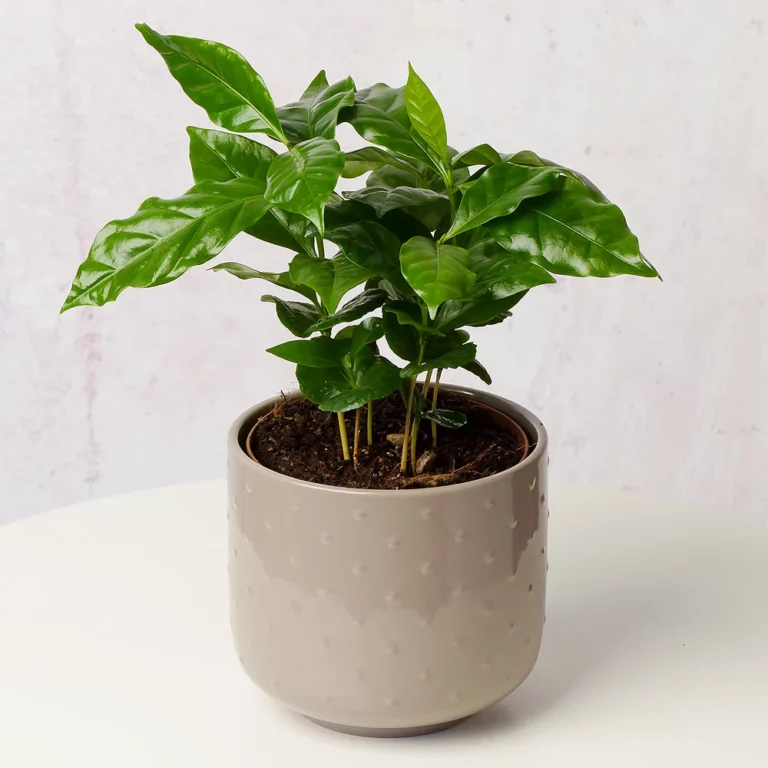With its shiny green leaves and compact growth habit, the Coffee Plant is an attractive addition to anyone’s plant collection.
Originally from Ethiopia, the coffee plant (Coffea arabica) is capable of flowering in the spring with small white blooms that eventually lead to half-inch berries. As these berries mature, they darken from green to a deep blackish hue, and inside each fruit are two seeds that we all know and love as coffee beans.
While the coffee plant can grow into a medium-sized tree in its native habitat, it can also be pruned to a more manageable size, making it a great choice for indoor cultivation.
Although coffee plants are vigorous growers, it may take a few years before your plant produces flowers and fruits. Also, it’s important to note that similar to the Jelly Bean plant, all parts of the plant are toxic to both humans and animals.
Care
If you’re interested in growing coffee plants, it’s essential to mimic their natural environment to ensure optimal growth. These plants thrive in mid-elevation tropical mountainsides, which have plenty of water with good drainage, high humidity, cool temperatures, and slightly acidic soil.
- Light: Avoid direct sunlight as coffee plants are understory plants and prefer shadier conditions.
- Soil: plant them in a rich, peat-based potting soil with excellent drainage. These plants prefer acidic soil, so if the plant is not thriving, add organic matter such as sphagnum peat moss to lower soil pH to a range closer to 6 to 6.5.
- Water: Coffee plants require moist soil, so be prepared to water them regularly, about once a week, and ensure the soil remains moist but not waterlogged.
- Temperature: it’s important to maintain a steady temperature range of between 70 to 80 degrees Fahrenheit during the day and 65 to 70 degrees Fahrenheit at night.
Propagation
Just like Zucchinis, you can propagate Coffee Plants from cuttings or from seeds. Both methods are pretty simple and thankfully, you can do them without much gardening experience.
If you have a coffee plant, you can sprout its cherries’ seeds to grow new plants. Pick the bright crimson cherries and clean the seeds, then soak them in water for a day before sowing them in damp, well-draining sand. Water daily, and after two to four months, you can plant each seed in well-draining, acidic soil, and water twice a week.
If you want to use cuttings, take one or more stems of at least 15 cm and plant them in fresh potting soil. For faster growth, wrap a plastic bag around the pot to create a humid environment. Place the cutting in a bright and warm spot, regularly moisten the leaves with a sprayer, and water the cuttings once every two weeks. When the cutting has roots of 5 to 10 cm, remove the plastic bag and repot it.
Common Pests
Pruning
Coffee trees are like speedy growers on a mission. In their early years, they sprout branches like there’s no tomorrow, focusing all their energy on creating wood. This pays off with a hefty berry harvest initially. But here’s the twist: coffee trees age at warp speed. They gobble up all the soil’s mineral salts to nourish their branches, leaving them unable to produce a bounty of berries.
That’s where pruning steps in to save the day! By snipping away excess branches, we help coffee trees find their groove and grow beautifully. We shape them into magnificent, strong specimens that will stand tall and proud. These coffee trees have a tendency to reach for the sky, growing up to 10 or 15 meters.
Different coffee tree varieties require specific pruning techniques. For those elegant Arabica, Liberica, Gros Indénié, and Excelsa coffee trees with a single main stem, it’s as simple as this:
- Trim the top to keep them around 1.5 to 2 meters in height
- Snip away branches near the trunk’s base, and select only the finest, thickest branches to stay.
- Cut the small, unnecessary branches, deadwood, and disease-ridden ones!
Frequently Asked Questions
Pretty easy, but remember: Coffee plants require shade, indirect sunlight, temperatures between 70-85 degrees, and a moist soil environment with regular misting due to their tropical, humid forest origins.
Do coffee plants smell of coffee?
No, coffee plants do not typically have a strong aroma of coffee. The scent of coffee comes from the roasted beans, not the plant itself.
How do you take care of a coffee plant?
To take care of a coffee plant, keep the temperature between 16-24ºC, water regularly without over-watering, and feed every two weeks during the growing season. To maintain high humidity, place the plant in a tray of pebbles filled with water and mist the leaves regularly.
Does a coffee plant last 25 years?
Well, coffee plants can even last for 50 years! But the fruit yield drops after 30…
How many years does it take for coffee to grow?
Coffee trees can take around 3 to 4 years to start bearing fruit, and the coffee cherry is picked once a year when it turns bright red.

